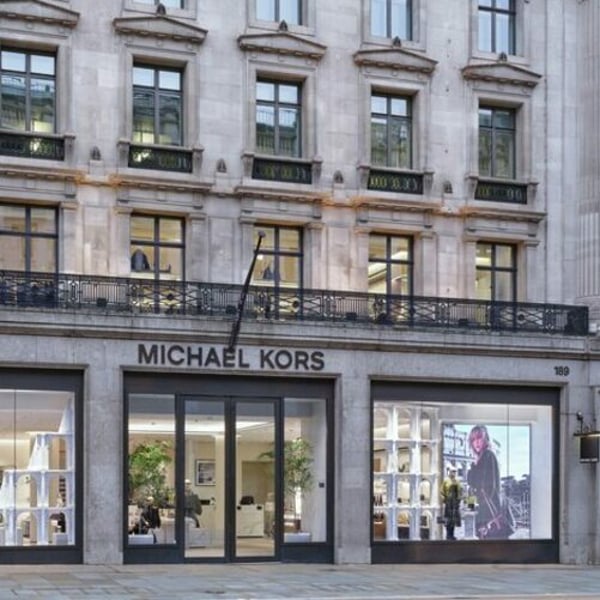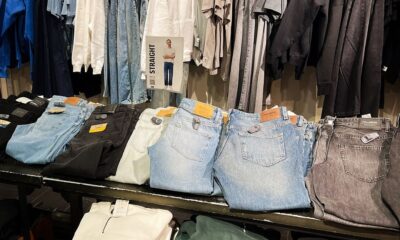Fashion
Michael Kors opens Regent Street flagship

Published
September 19, 2025
Michael Kors has opened a new London flagship with a debut at 187-191 Regent Street that reflects the brand’s latest store design concept, “with a focus on pared-down luxury and sophisticated glamour”. It’s in the space formerly occupied by the now-relocated Lululemon.
The two-storey flagship, spanning 848 square metres, carries an assortment of Michael Kors ready-to-wear and accessories, including handbags and small leather goods, footwear, sunglasses, watches, jewellery and more.
The store will also carry a selection of leather goods, RTW, footwear, and accessories from Michael Kors Mens.
And the company said it’s all “designed to reflect the Michael Kors jet-set lifestyle, the store will bring to life the brand’s seasonal campaigns and immerse customers in the featured destination of the season with unique visual displays”.
Not that we should expect anything too OTT. We’re told the new store design also “showcases the brand’s laid-back approach to luxury, with an emphasis elegance and ease”.
Elements inside include polished marble surfaces, sleek wood flooring and finishes, and plush fabrics. The design and colour palette are inspired by warm neutrals and natural textures. Floating displays, vivid lighting, and expansive windows are intense to “create a relaxed ambiance, allowing guests to explore the brand’s product assortment while offering a reprieve from the hustle and bustle of Regent Street”.

Kors himself said: “Our new store epitomises the incredible mix of styles you find in London. It’s confident, cool, understated and modern—the perfect destination to immerse yourself in our brand’s rich heritage.”
To celebrate the opening, the store will host a ‘Make Your Own Charm’ bar every Friday through Sunday from September 18 to October 12. Throughout the month-long activation, Michael Kors will collaborate with local artists to lead live charm-making sessions, allowing customers to customise their handbag charms in-store.
Copyright © 2025 FashionNetwork.com All rights reserved.
Fashion
CFDA to implement fur ban at NYFW from September 2026
Fashion
ECB keeps interest rates unchanged, upgrades growth outlook

According to updated Eurosystem staff projections, headline inflation is expected to average 2.1 per cent in 2025, easing to 1.9 per cent in 2026 and 1.8 per cent in 2027, before returning to 2.0 per cent in 2028. Inflation excluding energy and food is forecast at 2.4 per cent in 2025, gradually declining to 2.0 per cent by 2028. Inflation for 2026 has been revised upward, mainly due to expectations that services inflation will fall more slowly than previously anticipated, the Governing Council of the ECB said in a press release.
European Central Bank has kept its key interest rates unchanged, maintaining confidence that inflation will stabilise at the 2 per cent target.
Updated projections show inflation easing gradually over the coming years, with a slight upward revision for 2026 due to persistent services prices.
Economic growth forecasts have been revised higher, supported by stronger domestic demand.
The ECB also revised its economic growth outlook higher compared with its September projections. Growth is now expected to reach 1.4 per cent in 2025, 1.2 per cent in 2026 and 1.4 per cent in 2027, with expansion projected to remain at 1.4 per cent in 2028. The improvement is driven largely by stronger domestic demand across the euro area.
The Council reiterated its commitment to ensuring that inflation stabilises sustainably at the 2 per cent target. It emphasised that future monetary policy decisions will remain data-dependent and assessed on a meeting-by-meeting basis, without pre-committing to any specific interest rate path.
Fibre2Fashion News Desk (KD)
Fashion
US brand Vera Bradley posts net revenue of $62.3 million in Q3

Vera Bradley reported Q3 net revenues of $62.3 million, down from $70.5 million year over year.
Direct revenues fell 5.3 per cent, with comparable sales down 5.8 per cent, while indirect revenues dropped 30.2 per cent.
Gross margin declined to 42.1 per cent, impacted by inventory write-downs and higher duties, despite early progress from its Project Sunshine transformation.
Source link
-

 Business6 days ago
Business6 days agoHitting The ‘High Notes’ In Ties: Nepal Set To Lift Ban On Indian Bills Above ₹100
-

 Politics1 week ago
Politics1 week agoTrump launches gold card programme for expedited visas with a $1m price tag
-

 Business1 week ago
Business1 week agoRivian turns to AI, autonomy to woo investors as EV sales stall
-

 Sports1 week ago
Sports1 week agoPolice detain Michigan head football coach Sherrone Moore after firing, salacious details emerge: report
-

 Fashion1 week ago
Fashion1 week agoTommy Hilfiger appoints Sergio Pérez as global menswear ambassador
-

 Business1 week ago
Business1 week agoCoca-Cola taps COO Henrique Braun to replace James Quincey as CEO in 2026
-

 Sports1 week ago
Sports1 week agoU.S. House passes bill to combat stadium drones
-

 Tech1 week ago
Tech1 week agoGoogle DeepMind partners with UK government to deliver AI | Computer Weekly



















